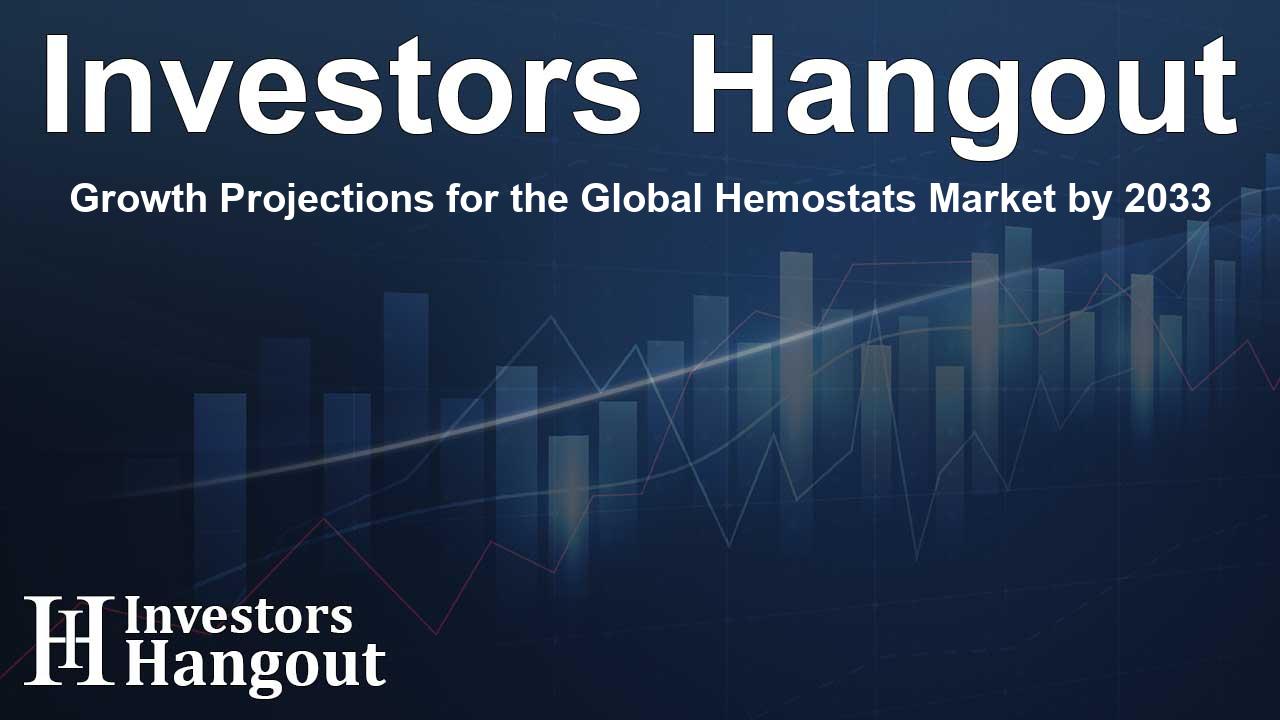Growth Projections for the Global Hemostats Market by 2033

Overview of the Hemostats Market
The hemostats market is experiencing significant growth, with its estimated value soaring from approximately 2.88 billion to an expected 4.84 billion dollars by 2033. This growth is projected at a compound annual growth rate (CAGR) of 5.92% from 2025 to 2033, as more surgical operations demand efficient bleeding control solutions.
Factors Driving Market Demand
As the population ages and technology in healthcare progresses, the demand for surgical interventions is rising sharply. With lifestyle diseases becoming increasingly prevalent, surgical procedures are necessary to treat various conditions. The World Health Organization reported a considerable number of surgeries performed worldwide, establishing the pressing need for effective hemostatic products. In 2023 alone, nearly 17 million surgeries were conducted in certain hospital systems, showcasing the consistent requirement for hemostatic agents like thrombin sealants and flowable gelatin matrices.
Changing Surgical Landscape
The evolving nature of surgical interventions is also influencing hemostatic product utilization. The rise of minimally invasive techniques has created a demand for quicker and more efficient bleeding control methods. Surgeons now favor ready-to-use hemostatic agents that can be applied easily during procedures while minimizing operating times. The outpatient care model, with its emphasis on rapid turnover, selects single-use products to accommodate high-volume scenarios, driving the hemostats market further into the spotlight.
Key Market Insights
Several trends and challenges are shaping the hemostats market. On the positive side, major drivers of growth include the rising number of trauma cases and investments in medical facilities. However, there are hurdles as well, such as rising costs associated with raw materials like chitosan and collagen, impacting overall pricing dynamics.
Innovations in Hemostatic Products
The importance of innovation is more pivotal than ever in the hemostats market. New developments are drawing from military medical practices. For instance, advanced hemostatic products, initially designed for battlefield emergencies, are now being implemented in civilian healthcare. This crossover not only enhances treatment efficacy in emergency scenarios but also streamlines supply chains to ensure that these critical products are readily available when needed.
Regulatory Landscape Changes
As the hemostatic market grows, so too does the scrutiny of regulatory agencies. Newer products are undergoing faster approval processes through initiatives aimed at expediting access to innovative treatment options. While some agencies are tightening regulations and increasing evidence requirements, others are providing streamlined paths for approved hemostatic devices, contrasting regulatory environments such as in the U.S. versus Europe.
The Impact of Cost and Quality on Procurement
In recent years, hospitals have shifted their procurement strategies from focusing solely on unit prices to considering overall value. As hospitals aim for better health outcomes linked to product efficacy, vendors providing evidence-backed hemostatic solutions are likely to garner preference, leading to a dynamic shift in purchasing behaviors within the sector.
Challenges and Opportunities Ahead
While the hemostats market appears promising, several challenges loom. The continued volatility of supply chains, particularly concerning raw materials like chitosan due to environmental changes, emphasizes the need for robust risk management strategies. Moreover, the cost structure for these critical materials continues to evolve, prompting manufacturers to develop new, sustainable sourcing methods.
Focus on Sustainability and Technological Integration
Looking to the future, the hemostats market must embrace sustainability. Environmental impact has become a priority for healthcare providers, leading to demands for biodegradable products and those with a lower carbon footprint. Additionally, technological advancements, including integrating data analytics into hemostatic solutions, are set to redefine industry standards, ensuring products not only meet but exceed contemporary healthcare expectations.
Frequently Asked Questions
What is the projected market value for hemostats by 2033?
The hemostats market is projected to reach over US$ 4.83 billion by 2033.
What are the primary factors driving the growth of the hemostats market?
The growth is driven by an increase in surgical procedures, demand for efficient bleeding control products, and investments in surgical technologies.
How are military medicine innovations impacting the hemostats market?
Military practices are influencing product designs and applications, expanding market reach and improving civilian medical responses.
What challenges does the hemostats market currently face?
Challenges include rising raw material costs, tight regulatory scrutiny, and increasing demand for rapid product availability.
What future trends are anticipated in the hemostatics market?
Future trends include a focus on sustainability, precision, and the integration of advanced technologies into product offerings.
About The Author
Contact Olivia Taylor privately here. Or send an email with ATTN: Olivia Taylor as the subject to contact@investorshangout.com.
About Investors Hangout
Investors Hangout is a leading online stock forum for financial discussion and learning, offering a wide range of free tools and resources. It draws in traders of all levels, who exchange market knowledge, investigate trading tactics, and keep an eye on industry developments in real time. Featuring financial articles, stock message boards, quotes, charts, company profiles, and live news updates. Through cooperative learning and a wealth of informational resources, it helps users from novices creating their first portfolios to experts honing their techniques. Join Investors Hangout today: https://investorshangout.com/
The content of this article is based on factual, publicly available information and does not represent legal, financial, or investment advice. Investors Hangout does not offer financial advice, and the author is not a licensed financial advisor. Consult a qualified advisor before making any financial or investment decisions based on this article. This article should not be considered advice to purchase, sell, or hold any securities or other investments. If any of the material provided here is inaccurate, please contact us for corrections.
